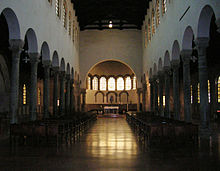San Giovanni Evangelista (Ravenna)
The Church of San Giovanni Evangelista in the Italian city of Ravenna on the Adriatic Sea is a basilica from the 5th century with a square, 42 meter high west tower from the 10th century. The church is located near the train station.
history
It is a votive basilica commissioned by the regent Galla Placidia , the construction of which began in 425. After the death of her brother, the Western Roman Emperor Honorius († 423), who had exiled her to Constantinople in 423 , Galla Placidia returned with her children from Constantinople to Ravenna to be there for her underage son Valentinian III. to take over the business of government. When she got caught in a heavy storm during the voyage by ship, she made the vow to have a church built and to dedicate it to John the Evangelist .
The church was located on the area of the imperial residence, which extended south of it and which was then expanded to the north. In later years the church was rebuilt several times and thus disfigured. In 1747 it was modernized. As part of extensive restoration work on the occasion of the Dante centenary in 1921, the basilica was given its old form back and the building was supplemented in moderation. During the Second World War , the basilica was badly damaged by American aerial bombs in 1944 because of its proximity to the train station . The bell tower survived the bombing raids largely undamaged. After the war, it was restored in an exemplary manner - as far as possible. A square columned walkway on the south side was replaced by a wall. In 1959 the wall was completely renewed.
The bell tower has tilted slightly to the north over the centuries, a result of the sandy-loamy subsoil on which the city of Ravenna is built. The interior of the three-aisled basilica is 49 meters by 22 meters. The two aisles are separated from the main nave by two rows of columns, each consisting of twelve columns. The pillars are significantly lower in the area of the choir, which shows the original level of the floor, which was lower. Because the original floor was on a lower level, the original building of the basilica - as with the other old buildings in Ravenna - should be imagined to be a bit higher and slimmer than it appears today. The columns made of gray marble ( Bigio antico ) have Roman capitals on which the original natural stone blocks, which are considered to be the oldest Ravennas, are stored.
The two church bells hanging in the bell tower were cast in 1208 by the German bell caster Robert the Saxon. The splendid mosaics in the apse , which depicted Galla Placidia in distress and portraits of some emperors, no longer exist. However, the old altar was put up again.
Furnishing
On the walls of the aisles there are fragments of a mosaic floor that was about two meters lower. The ones on the wall of the left aisle are from 1213. They mainly depict mythical animals and scenes from the Fourth Crusade . The goose with a censer and two taps with the (pseudo) dead fox are motifs from the chapter Death (burial) of the fox in the Roman de Renart (branch XVII). These are not artistically demanding achievements, but rather caricature-like, sketchy representations. On the left there is a chapel with ceiling paintings on the vault that date from the 14th century.
At the portal of the forecourt there are Gothic reliefs carved in light gray natural stone from 1317, which depict the granting of the sandal relics to Galla Placidia and the Annunciation.
organ
The organ in the penultimate arcade between the central and left aisles was built in 1974 by the Mascioni organ building company. The instrument has 8 registers on two manuals and a pedal . The actions are mechanical.
|
|
|
||||||||||||||||||||||||||||||||
Bells
The two church bells of the basilica are said to have a melancholy minor tone. Since the bell founder Robert the Saxon had brought his daughter with him from Germany in 1208 to help with the bell casting, the melancholy sound of the two church bells has since been associated with the following legend: When she arrived in Ravenna, the daughter fell in love and then shed many tears out of lovesickness. The tears also fell into the melting pot, which is what caused the peculiar sound of the bells.
Pictures of the interior
Individual evidence
- ↑ mosaicocidm. With Corteo funebre di animali
- ↑ mosaicocidm.it Funerale della volpe
- ↑ Information on the organ
Web links
Coordinates: 44 ° 25 ′ 4.5 ″ N , 12 ° 12 ′ 19.9 ″ E











